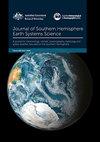RCP4.5和RCP8.5情景下巴西地球系统模式模拟的南半球海洋海面高度趋势
IF 3.6
4区 地球科学
Q1 Earth and Planetary Sciences
引用次数: 3
摘要
巴西地球系统模式(bsm - oa2.5)在模拟耦合模式比对项目(CMIP5)第五阶段提出的历史时期时,发现南半球海洋的海面高度(SSH)相对于工业化前时代有增加的趋势。在CMIP5、RCP4.5和RCP8.5未来情景中,随着大气中温室气体浓度的增加,这种增加趋势更加明显。这项研究揭示了这些地区这种趋势的来源。结果表明,由于这些未来情景造成的逐渐变暖,与700米以上海洋的热膨胀有关。在1850 ~ 2005年间,bsm - oa2.5地表高度增加了0.11m。关于未来的预测,bsm - oa2.5预测,到2100年底,RCP4.5和RCP8.5的海平面高度将分别增加0.14和0.23米(相对于2005年的历史值)。这些增加主要发生在大西洋和印度洋35-60°S纬度范围内。另外三个CMIP5模式的结果证实了bsm - oa2.5模拟中探测到的趋势信号的可重复性。本文章由计算机程序翻译,如有差异,请以英文原文为准。
Sea surface height trends in the southern hemisphere oceans simulated by the Brazilian Earth System Model under RCP4.5 and RCP8.5 scenarios
The Brazilian Earth System Model (BESM-OA2.5), while simulating the historical period proposed by the fifth phase of the Coupled Model Intercomparison Project (CMIP5), detects an increasing trend in the sea surface height (SSH) on the southern hemisphere oceans relative to that of the pre-industrial era. The increasing trend is accentuated in the CMIP5 RCP4.5 and RCP8.5 future scenarios with higher concentrations of greenhouse gases in the atmosphere. This study sheds light on the sources of such trends in these regions. The results suggest an association with the thermal expansion of the oceans in the upper 700m due to a gradual warming inflicted by those future scenarios. BESM-OA2.5 presents a surface height increase of 0.11m in the historical period of 1850–2005. Concerning future projections, BESM-OA2.5 projects SSH increases of 0.14 and 0.23m (relative to the historical 2005 value) for RCP4.5 and RCP8.5, respectively, by the end of 2100. These increases are predominantly in a band of latitude within 35–60°S in the Atlantic and Indian oceans. The reproducibility of the trend signal detected in the BESM-OA2.5 simulations is confirmed by the results of three other CMIP5 models.
求助全文
通过发布文献求助,成功后即可免费获取论文全文。
去求助
来源期刊

Journal of Southern Hemisphere Earth Systems Science
Earth and Planetary Sciences-Oceanography
CiteScore
8.10
自引率
8.30%
发文量
0
审稿时长
>12 weeks
期刊介绍:
The Journal of Southern Hemisphere Earth Systems Science (JSHESS) publishes broad areas of research with a distinct emphasis on the Southern Hemisphere. The scope of the Journal encompasses the study of the mean state, variability and change of the atmosphere, oceans, and land surface, including the cryosphere, from hemispheric to regional scales.
general circulation of the atmosphere and oceans,
climate change and variability ,
climate impacts,
climate modelling ,
past change in the climate system including palaeoclimate variability,
atmospheric dynamics,
synoptic meteorology,
mesoscale meteorology and severe weather,
tropical meteorology,
observation systems,
remote sensing of atmospheric, oceanic and land surface processes,
weather, climate and ocean prediction,
atmospheric and oceanic composition and chemistry,
physical oceanography,
air‐sea interactions,
coastal zone processes,
hydrology,
cryosphere‐atmosphere interactions,
land surface‐atmosphere interactions,
space weather, including impacts and mitigation on technology,
ionospheric, magnetospheric, auroral and space physics,
data assimilation applied to the above subject areas .
Authors are encouraged to contact the Editor for specific advice on whether the subject matter of a proposed submission is appropriate for the Journal of Southern Hemisphere Earth Systems Science.
 求助内容:
求助内容: 应助结果提醒方式:
应助结果提醒方式:


